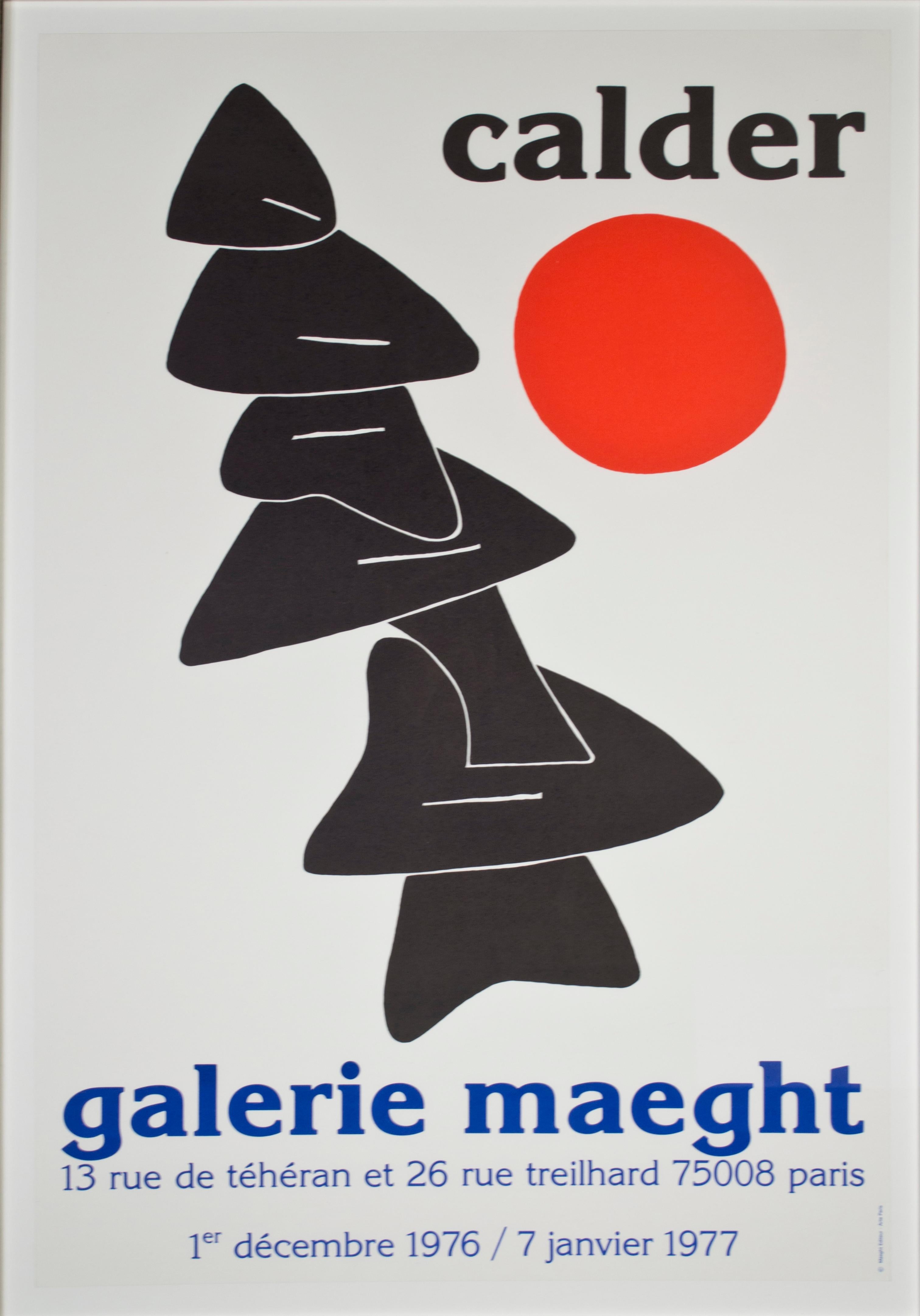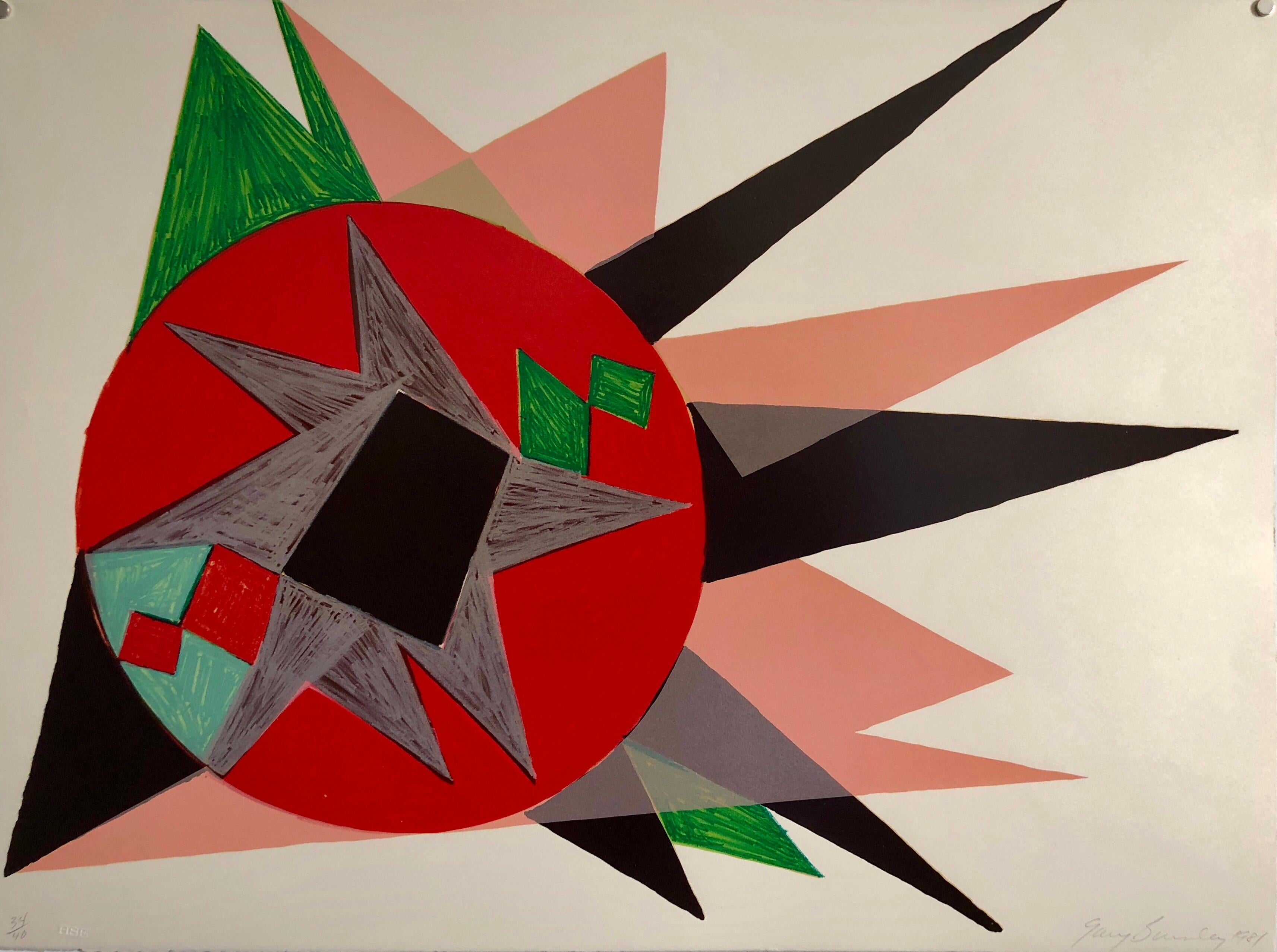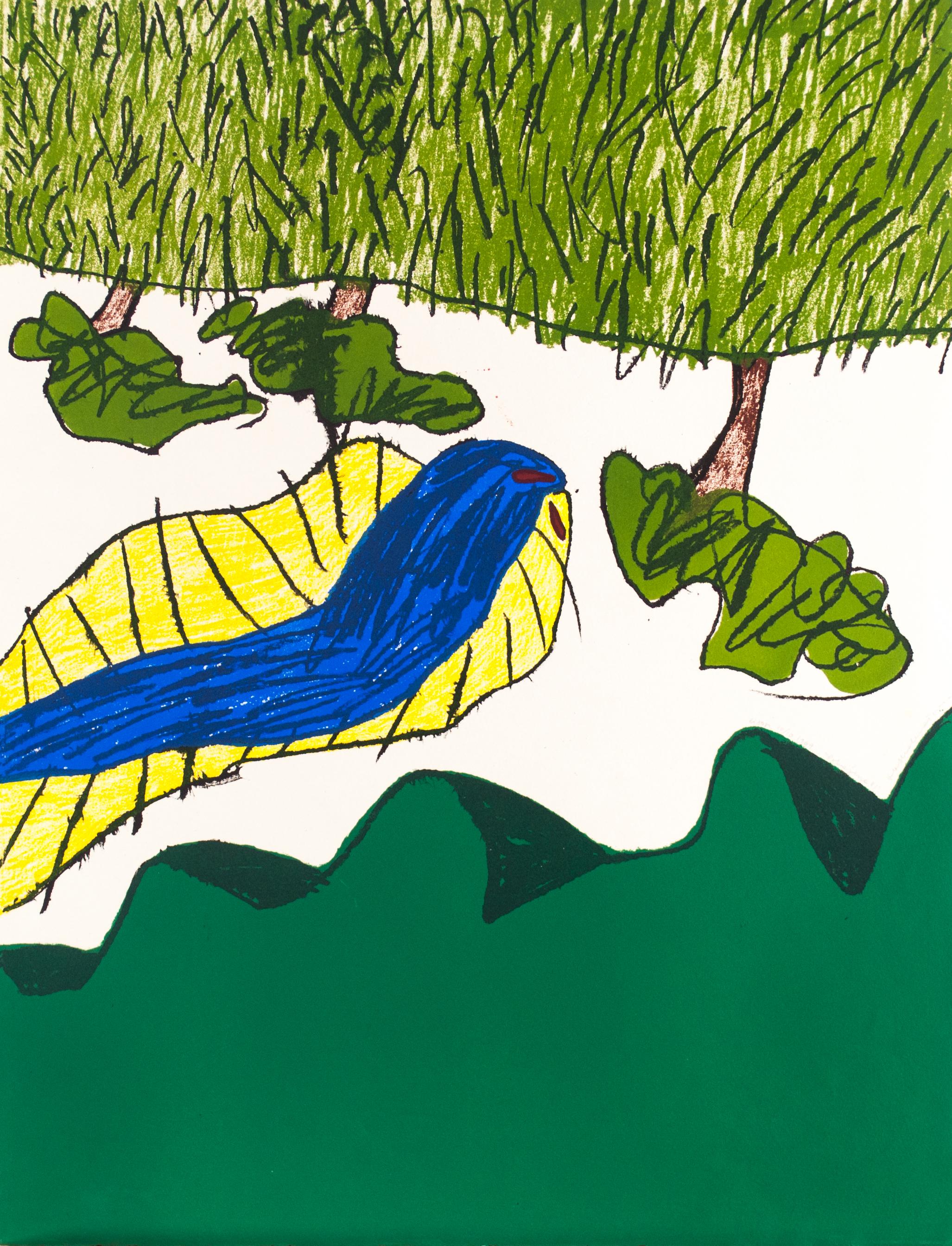Items Similar to "Galerie Maeght, " Graphic Color Lines Lithograph Poster by Jean Rene Bazaine
Want more images or videos?
Request additional images or videos from the seller
1 of 7
Jean Rene Bazaine"Galerie Maeght, " Graphic Color Lines Lithograph Poster by Jean Rene Bazaine1974
1974
About the Item
"Galerie Maeght" lithograph poster by Jean Rene Bazaine. This poster holds Bazine's name in harsh orange lines near the top of the piece. Diagonally bisecting the b and a in Bazaine is a teal line. Bellow this horizontally against the white backgrounds are two lines, one painted yellow and the other blue.
Image: 29 x 21 in
Jean Bazaine was a French painter, designer of stained glass windows, and writer. He was the great great grandson of the English Court portraitist Sir George Hayter. In 1949/1950 he had his first major one man show at the Galerie Maeght, who remained his art dealer thenceforth. From then on it was a steady progress of major exhibitions: Bern, Hanover, Zürich, Oslo... 1987 a retrospective exhibition in Galerie Maeght, 1988 a retrospective of his drawings in the Musée Matisse and finally in 1990 the Exposition Bazaine in the Galeries Nationales du Grand Palais, Paris., which was accompanied by the reissue of his major texts on painting in art theory as Le temps de la peinture (Paris, Aubier 1990). "The motley crowds of international tourists and souvenir-shoppers who fill the ancient streets of the Latin Quarter in Paris spend most of their time admiring the open-air displays of seafood outside the Greek restaurants in the rue de la Huchette. They ignore the beautiful church of St Severin in the same street, for have they not already "done" Notre Dame? So they miss one of the most wonderful series of stained-glass windows in France: Jean Bazaine's vivid, dynamic works irradiating the sombre ambulatory and apsidal chapels. These windows represent the seven sacraments of the Church, portrayed as essential forms from nature in all its glory and symbolising Water, Fire and Light, sacred emblems of Divine Grace. An appropriate biblical verse is inscribed beneath each. Only Pierre Soulages with his "luminous black" windows at l'Abbaye de Conques (1998) can stand comparison with the majesty of these contemporary works by Bazaine, created between 1965 and 1970. Bazaine was fortunate in his friends. He received at an early stage in his student career support and advice from another master colourist, Pierre Bonnard. In his youth he knew Leger, Braque, James Joyce and Marcel Proust. One of his great personal friends was Jean Fautrier, with whom he shared his first exhibition in 1930. His work gradually developed as a form of bold tachisme - brilliantly composed but well-controlled "splashes" of sumptuous colour. He rejected the term "abstract" which he considered a denial of the essentially intimate relationships between art and reality. He quoted his friend Braque: "The canvas must efface the idea behind it." In 1941, during the Nazi occupation, at a time when Hitler was destroying many works of modern art, Bazaine had the courage to organise in Paris a first "avant-garde" exhibition of 20 French artists. In 1948, he wrote his first book, an unpedantic, unacademic view of contemporary painting, Notes sur la peinture d'aujourd'hui. He quotes Braque on Cezanne: "He's a painters' painter - other people think it's unfinished." Bazaine, too, reverenced Cezanne: Three lines drawn by Cezanne overturn our whole concept of the world, proclaim the liberty of man, his courage. The great painters have never had any other aims. The painter says: "I exist, therefore you exist. I am free, therefore you are free. Or at least he tries to. It's his one aim in life." After the Second World War, Bazaine produced vast compositions with virtuoso colour structures, mostly with references to nature, like the breathtaking Vent de mer (1949, now in the Museum of Modern Art, Paris) and Orage au jardin (1952, now in the Van Abbemuseum at Eindhoven). His Earth and Sky (1950) is in the Maeght Foundation at Saint Paul de Vence. One of his greatest works, L'Arbre tenebreux (1962), was sold to the Sonja Henie-Niels Foundation in Norway. These enormous, evocative representations of the forces of nature were always preceded by numerous sketches, drawings and colour value notations that are in themselves fascinating insights into the painter's techniques in the production of apparently spontaneous burst of colour and contrasts of movement and subtleties of tone. Bazaine was a natural choice for large-scale architectural and literary collaborations. He made magnificent illustrations for poetry by André Frenaud, René Char and Jean Tardieu: unlike most painters, he was a passionate lover of poetry, and could express the very essence of a poem in an astonishing feat of almost mediumistic artistic insight into the subject. He created the immense mosaic composition for the Unesco building in Paris (1960), as well as decorations for the transatlantic liner France (1962) and the Maison de la Radio (1963). His monumental gift can be found also in more mundane surroundings like the Cluny metro station. But it is as an inspired creator of works enriching the entire history of modern religious art that Bazaine will best be remembered, by believers and non-believers alike: the windows in the church at Asay (1943-47) in Savoie, the façade mosaics (1951) and windows (1954) of the church at Audincourt in the Jura (1954), the church of Villeparisis (1961) and a reception centre at Noisy le Grand (1955). He also devised tapestries, like the Blasons des douze mois (1975). Among his writing on art, there is Exercise de la peinture (1973) and La Temps de la peinture, a collection of all his writings on painting and the arts in general (1985). Jean Bazaine was a great master, but a humble one. He once confessed that he thought of suicide at least three times every day, so in despair did he feel about his work. One of his favourite quotations in Notes sur la peinture d'aujourd'hui comes, surprisingly, from the classicist Jacques Louis David: I would like a painter, at the end of 20 years of work, to begin each new painting in a state of the same indecision as when he started. And as epigraph to his L'exercise de la peinture Bazaine wrote: Linked for 20,000 years - and for just as long in times to come - to the destiny of man, painting has not lost any of its mystery. And this essay cannot hope to explain it. But the explanation is in every one of his paintings." Article Written by James Kirup
- Creator:Jean Rene Bazaine
- Creation Year:1974
- Dimensions:Height: 29 in (73.66 cm)Width: 21 in (53.34 cm)
- Medium:
- Movement & Style:
- Period:
- Condition:
- Gallery Location:Milwaukee, WI
- Reference Number:
About the Seller
4.9
Platinum Seller
These expertly vetted sellers are 1stDibs' most experienced sellers and are rated highest by our customers.
Established in 1966
1stDibs seller since 2017
391 sales on 1stDibs
Typical response time: 1 hour
- ShippingRetrieving quote...Ships From: Milwaukee, WI
- Return PolicyA return for this item may be initiated within 14 days of delivery.
More From This SellerView All
- "Stabile with Red Sun Galerie Maeght, " Original Lithograph Poster by A. CalderBy Alexander CalderLocated in Milwaukee, WI"Stabile with Red Sun Galerie Maught" is an original color lithograph by Alexander Calder. The Stabile is a black topsy-turvy statue taking up most of the piece. A red sun sits to th...Category
1970s Post-Modern Abstract Prints
MaterialsLithograph
- "Butter Bug, " Original Etching by Nicolee TeegardenLocated in Milwaukee, WI"Butter Bug" is an original etching by Nicolee Teegarden. This piece features abstract, biomorphic swirls in black and white. 9" x 5" art 17" x 14" frame Taught art at Tremper Hig...Category
1970s Post-Modern Abstract Prints
MaterialsEtching
- "Don't Wine, " Original Surreal Serigraph by Paula Schuette Kraemer & Bill WeegeBy Paula Schuette KraemerLocated in Milwaukee, WI"Don't Wine" is a mixed media piece, predominately a serigraph, by Paula Schuette Kramer and Bill Weege. Both artists signed in pencil in the lower right, and the title is in the lower left. It is one of a an edition of 50. The print is an explosion of bright colors, but red, blue, and green dominated the composition as they fade through the background. A blue figure climbs up a ladder out of an apple, hefting a large wine bottle overhead, which they pour out into the sea of wine. A man, woman, and long-necked orange bird also look out from the apple, reading for the stem of a floating bunch of green grapes. A group surrounds the grapes with their heads and shoulders above the water, eating the fruit. Birds fly through the background, dodging wine glasses and a vase of flowers that seem to be tumbling from a flying carpet. The entire image feels very surreal. Art size: 12" x 10" Frame size: 19 1/4" x 17" Paula Schuette Kraemer is an independent artist living in Madison, Wisconsin...Category
1990s Post-Modern Abstract Prints
MaterialsMixed Media
- 'Oasis' signed color lithograph (2/10)By Joseph RozmanLocated in Milwaukee, WIArt: 11-1/4 x 11-7/8 Color lithograph, signed (2/10) Joseph Rozman was born on December 26, 1944 in Milwaukee, WI. He was the first artist to have a solo exhibition at the David Barnett Gallery...Category
1960s Abstract Prints
MaterialsLithograph
- "Departing Beauty" & "Dreams, " Double-sided Colored LithographBy Alphonse MuchaLocated in Milwaukee, WI"Departing Beauty" and "Dreams" are two sides of one double-sided original lithograph by Art Nouveau master Alphonse Mucha. These illustrations were pages 94 & 93 of "Ilsee, Princess...Category
1890s Art Nouveau Abstract Prints
MaterialsLithograph
- "Bacchanale from Je Reve (I Dream) Portfolio, " Original Color LithographBy André MassonLocated in Milwaukee, WI"Bacchanale" is an original color lithograph by Andre Masson. This piece is from the Je Reve (I Dream) portfolio and is edition number H.C. XVV/XVV. Masson signed the piece in pencil...Category
1970s Surrealist Figurative Prints
MaterialsLithograph
You May Also Like
- The Songs of the Blacks and the BluesBy Louise BourgeoisLocated in Ljubljana, SIThe Songs of the Blacks and the Blues. Original color lithograph, woodcut, gouache and oil-stick editions, 1996. Edition of 40 signed and numbered impressions on Arches paper. Louise...Category
1990s Post-Modern Abstract Prints
MaterialsMixed Media, Gouache, Lithograph, Woodcut
- Italian Post Modern Pop Art Lithograph Silkscreen Valerio Adami Galerie MaeghtBy Valerio AdamiLocated in Surfside, FLTitled Ledoux, color limited edition lithograph. Hand signed by artist in pencil to right hand corner, 101/150 to left. 19.5" X 14" print view area. This is done in a Postmodernist, Memphis Milano style. Valerio Adami (born 17 March 1935) is an Italian painter. Educated at the Accademia di Brera in Milan, he has since worked in both London and Paris. His art is influenced by Pop Art. Adami was born in Bologna. In 1945, at the age of ten, he began to study painting under the instruction of Felice Carena. He was accepted into the Brera Academy (Accademia di Brera) in 1951, and there studied as a draughtsman until 1954 in the studio of Achille Funi. In 1955 he went to Paris, where he met and was influenced by Roberto Matta and Wifredo Lam. His first solo exhibition came in 1959 in Milan. In his early career, Adami's works were expressionistic, but by the time of his second exhibition in 1964 at Kassel, he had developed a style of painting reminiscent of French cloisonnism, featuring regions of flat color bordered by black lines. Unlike Gauguin, however, Adami's subjects were highly stylized and often presented in fragments. In the 1970s, Adami began to address politics in his art, and incorporated subject matter such as modern European history, literature, philosophy, and mythology. In 1971, he and his brother Giancarlo created the film Vacances dans le désert. In 1974 he illustrated a Helmut Heissenbuttel poem, Occasional Poem No. 27. Ten Lessons on the Reich with ten original lithographs {Galerie Maeght}. In 1975, the philosopher Jacques Derrida devoted a long essay, "+R: Into the Bargain", to Adami's work, using an exhibition of Adami's drawings as a pretext to discuss the function of "the letter and the proper name in painting", with reference to "narration, technical reproduction, ideology, the phoneme, the biographeme, and politics". The Galerie Maeght is a gallery of modern art in Paris, France, and Barcelona, Catalonia, Spain. The gallery was founded in 1936 in Cannes. The Paris gallery was started in 1946 by Aimé Maeght. The artists exhibited are mainly from France and Spain. Since 1945, the gallery has presented the greatest modern artists such as Matisse, Bonnard, Braque, Miró, and Calder. In 1956, Adrien Maeght opened a new parisian venue. The second generation of “Maeght” artists was born: Bazaine, Andre Derain, Giacometti, Kelly, Raoul Ubac, then Riopelle, Antoni Tapies, Pol Bury and Adami, among others. There were four retrospective exhibits of Adami's work between 1985 and 1998. They were held in Paris, the Centre Julio-Gonzalez de Valence (Spain), Tel Aviv, and Buenos Aires. In 2010, the Boca Raton Museum of Art devoted a special exhibit to Adami's Post Modern paintings and drawings. Derriere le Miroir, the editor was Aimé Maeght. Derrière le Miroir is a French art magazine created in 1946 and published until 1982...Category
1980s Post-Modern Landscape Prints
MaterialsLithograph
- Lithograph w Gloss Overprinting Stacked Signs Post Modern 80s Memphis Milano EraLocated in Surfside, FLUntitled, 1981 (Stacked Signs Series) lithograph with Glosscote overprinting. Published by Holly Solomon Editions. (original gallery label photo is included for reference and not included in sale) Hand signed and numbered from limited edition of 40. This is a beautiful piece perfect for the Memphis Milano early 1980's Post Modern Era. It also bears influence from Pop Art (Particularly Allan D'Arcangelo) Gary Burnley...Category
1980s Post-Modern Abstract Prints
MaterialsLithograph
- Upside downLocated in Ljubljana, SIUpside down. Original color lithograph, 1969. Edition of 10 signed and numbered impressions on Arches paper. Metka Krašovec is one of the most important painters in contemporary Slov...Category
1960s Post-Modern Abstract Prints
MaterialsLithograph
- Derriere le Miroir #221By Alexander CalderLocated in Washington, DCArtist: Alexander Calder Title: Derriere le Miroir #221 Portfolio: Derriere le Miroir #221 Medium: Lithograph in colors Date: 1975 Edition: Unnumbered Sheet Size: 15" x 22" Image Siz...Category
1970s Post-Modern Abstract Prints
MaterialsLithograph
- OlympiaBy Friedensreich HundertwasserLocated in Ljubljana, SIOriginal signed color poster lithograph, 1983. Edition of 150 signed and numbered impressions on Arches paper. Art and Sport portfolio: The Yugoslav Olympic Committee of the Winter O...Category
1980s Post-Modern Abstract Prints
MaterialsLithograph
Recently Viewed
View AllMore Ways To Browse
Graphic Top
Shop By Dealers
Outside The Lines
Gift Poster
Greece Poster
French Painted Poster
James Jean
English Court
The Vintage Poster Shop
Vintage Inspired Posters
Vintage Inspired Poster
Rene Jean
Friends Poster
Greece Vintage Posters
Greece Posters Vintage
Saint Jean Paul
Avant Garde Poster
Large Lithograph Black White





